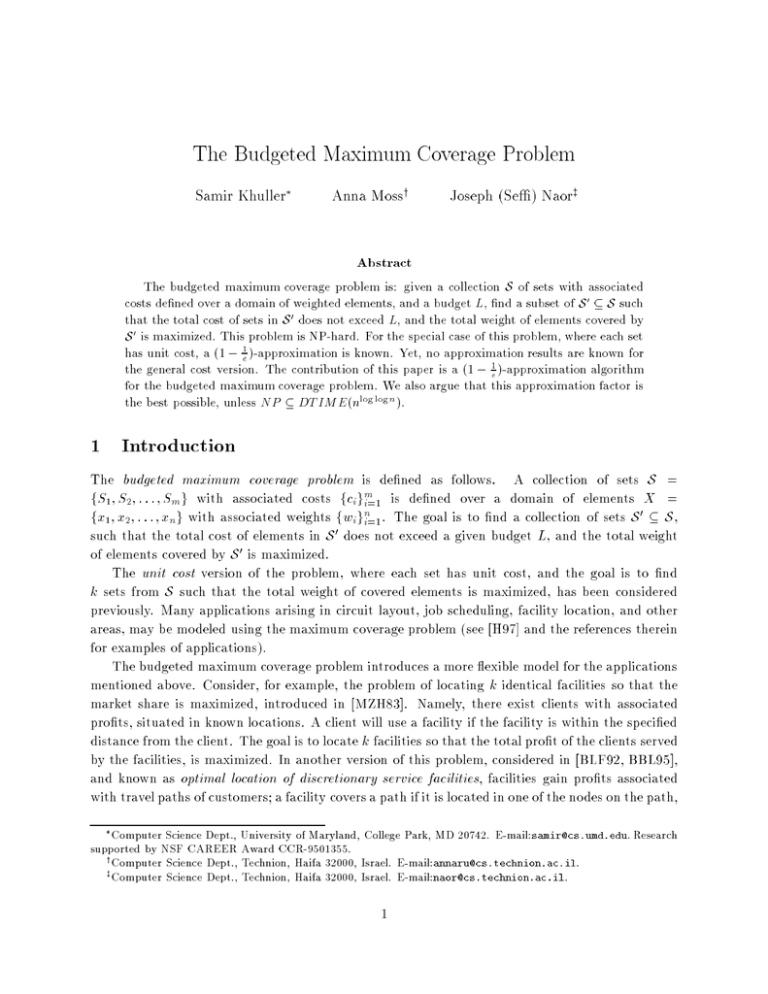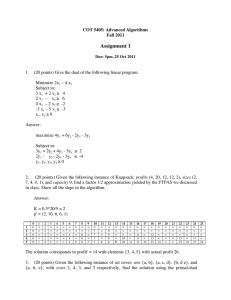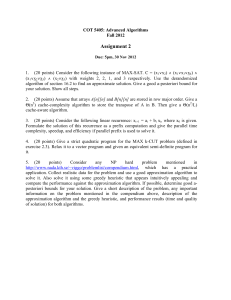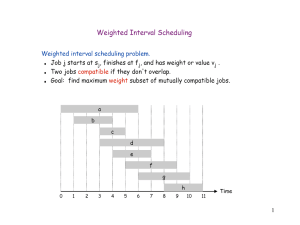The budgeted maximum coverage problem
advertisement

The Budgeted Maximum Coverage Problem Samir Khuller Anna Mossy Joseph (Se) Naorz Abstract The budgeted maximum coverage problem is: given a collection S of sets with associated costs dened over a domain of weighted elements, and a budget L, nd a subset of S S such that the total cost of sets in S does not exceed L, and the total weight of elements covered by S is maximized. This problem is NP-hard. For the special case of this problem, where each set has unit cost, a (1 1e )-approximation is known. Yet, no approximation results are known for the general cost version. The contribution of this paper is a (1 1e )-approximation algorithm for the budgeted maximum coverage problem. We also argue that this approximation factor is the best possible, unless NP DTIME (nlog log n ). 0 0 0 1 Introduction The budgeted maximum coverage problem is dened as follows. A collection of sets S = fS1; S2; : : :; Smg with associated costs fcigmi=1 is dened over a domain of elements X = fx1; x2; : : :; xng with associated weights fwigni=1. The goal is to nd a collection of sets S 0 S , such that the total cost of elements in S 0 does not exceed a given budget L, and the total weight of elements covered by S 0 is maximized. The unit cost version of the problem, where each set has unit cost, and the goal is to nd k sets from S such that the total weight of covered elements is maximized, has been considered previously. Many applications arising in circuit layout, job scheduling, facility location, and other areas, may be modeled using the maximum coverage problem (see [H97] and the references therein for examples of applications). The budgeted maximum coverage problem introduces a more exible model for the applications mentioned above. Consider, for example, the problem of locating k identical facilities so that the market share is maximized, introduced in [MZH83]. Namely, there exist clients with associated prots, situated in known locations. A client will use a facility if the facility is within the specied distance from the client. The goal is to locate k facilities so that the total prot of the clients served by the facilities, is maximized. In another version of this problem, considered in [BLF92, BBL95], and known as optimal location of discretionary service facilities, facilities gain prots associated with travel paths of customers; a facility covers a path if it is located in one of the nodes on the path, Computer Science Dept., University of Maryland, College Park, MD 20742. E-mail:samir@cs.umd.edu. Research supported by NSF CAREER Award CCR-9501355. y Computer Science Dept., Technion, Haifa 32000, Israel. E-mail:annaru@cs.technion.ac.il. z Computer Science Dept., Technion, Haifa 32000, Israel. E-mail:naor@cs.technion.ac.il. 1 or at some vertex \close" to the path. Clearly, the problems described above can be modeled by the unit cost maximum coverage problem. However, in practice, the cost of constructing a facility may depend on certain factors associated with the location of the facility. For example, each candidate site for constructing a facility is associated with some cost, and one is assigned a limited budget for constructing the facilities. This generalization of the problem of locating facilities to maximize market share is also discussed in [MZH83]. The budgeted maximum coverage problem is a model that allows us to handle this type of applications. Unfortunately, even the unit cost version of the maximum coverage problem is NP-hard, by a straightforward reduction from the set cover problem. Therefore, we look for an approximate solution which is near-optimal and computable in polynomial time. An approximation algorithm for a maximization problem is said to achieve approximation ratio , if the solution delivered by the algorithm for any instance of the problem is always at least the multiplicative factor of from the optimum for this instance. Several results related to the unit cost maximum coverage problem were presented in the literature. Nemhauser and Wolsey [NW81] and Conforti and Cornuejols [CC84] considered the general problem of maximizing submodular functions (a function f is called submodular if f (A) + f (B ) f (A [ B ) + f (A \ B ), for any sets A; B in the domain of f ). They have shown, in particular, that the greedy heuristic achieves an approximation factor of 1 (1 k1 )k > (1 1e ) for maximizing nondecreasing submodular functions satisfying f (;) = 0, where k is the maximum cardinality of sets in the optimization domain. Vohra and Hall [VH93] noted that the unit cost maximum coverage problem belongs to this class of problems. The greedy heuristic for the special case of the maximum coverage problem picks at each step a set maximizing the weight of the uncovered elements. Hochbaum and Pathria [HP94] (see also Hochbaum [H97]) presented an elegant analysis of the greedy heuristic. As we show in the sequel, the greedy heuristic cannot be trivially generalized to achieve a good approximation for the budgeted version of the problem. In this paper we present a (1 1e )-approximation algorithm for the budgeted maximum coverage problem. This is the rst approximation algorithm presented for the budgeted version of the problem. We show that a small modication to the greedy heuristic yields a constant approximation factor for this problem. We then show how to further improve the approximation factor to (1 1e ) using the enumeration technique. We argue that the latter approximation ratio is the best possible for the maximum coverage problem, in the sense that no approximation algorithm with performance guarantee (1 1e + ) exists for any > 0, unless NP DTIME (nloglog n ). The rest of the paper is organized as follows. In Section 2 we show that the greedy heuristic cannot achieve a good performance guarantee for the budgeted maximum coverage problem; we present an algorithm that achieves a constant factor approximation for this problem and analyze its performance guarantee. Section 3 presents an improved algorithm and the analysis of its performance guarantee. In Section 4 we present a bound on the hardness of approximation for the budgeted maximum coverage problem. 2 2 The Modied Greedy Algorithm Throughout the rest of this paper we use the following notation. Let fcigmi=1 denote the costs of the sets in S , let fwi gni=1 denote the weights of the elements in X , and let Wi be the total weight of the elements covered by set Si , i = 1; : : :; m. Let G S be a collection of sets. Let w(G) denote the total weight of the elements covered by G. Let Wi0 , i = 1; : : :; m, denote the total weight of the elements covered by set Si , but not covered by any set in G. Without loss of generality we may assume that the cost of each set does not exceed L, since sets of cost greater than L do not belong to any feasible solution. We rst observe that the greedy heuristic that picks at each step a set maximizing the ratio W 0 has an unbounded approximation factor. Consider, for example, two elements, x of weight 1 c 1 and x2 of weight p. Let Si = fxi g, i = 1; 2, let c1 = 1, c2 = p + 1, and let L = p + 1. The optimal solution contains the set S2 and has weight p, while the solution picked by the greedy heuristic contains the set S1 and has weight 1. The approximation factor for this instance is p, and is therefore unbounded. Next, we show that a small modication to the greedy heuristic achieves a constant approximation factor for the budgeted maximum coverage problem. The algorithm is as follows. i i Algorithm 1: G ;; C 0; U Repeat S; 0 select Si 2 U that maximizes Wc if C + ci L then i i U Until U = ; G G [ Si C C + ci U n Si Select a set St that maximizes Wt over S . If W (G) Wt , output G, otherwise, output fSt g Algorithm 1 nds a collection of sets according to the greedy heuristic. This collection is the rst candidate for the nal output. The second candidate is a single set St for which Wt is maximized. The algorithm outputs the candidate solution having the maximum weight. Next, we analyze the performance guarantee of Algorithm 1. Let OPT denote the collection of sets in an optimal solution. Let r be the number of iterations executed by the greedy heuristic (the \repeat loop") until the rst set from OPT is considered, but not added to G, because its addition would violate the budget L. Let l be the number of sets added to G in the rst r iterations. Without loss of generality, we may renumber the sets so that Si is the i-th set added to G, i = 1; : : :; l, and Sl+1 is the rst set from OPT selected by the algorithm but not added to G. Let Gi , i = 1; : : :; l + 1 denote [ij =1 Sj . Finally, let ji be the index of the iteration in which set Si was considered, i = 1; : : :; l + 1. The following two lemmas generalize the lemmas for the unit cost version of the problem, presented in [HP94] (see also [H97]). 3 Lemma 1: After each iteration ji, i = 1; : : :; l + 1, the following holds: w(Gi) w(Gi 1 ) cLi (w(OPT ) w(Gi 1)): Proof: Clearly, w(OPT ) w(Gi 1) is no more than the weight of the elements covered by OPT0 , but not covered by Gi 1 . For each set in OPT n Gi 1 , the ratio of weight to cost is at most Wc , since Si maximizes this ratio over all sets that had not been selected before iteration ji . Since the total cost of the sets in OPT n Gi 1 is bounded by the budget L, the total weight of the elements 0 W covered by the sets in OPT n Gi 1 and not covered by Gi 1 , is at most L c . Hence, we get i i i i 0 (1) w(OPT ) w(Gi 1 ) L Wc i : i But, from the denition of Wi0 , it follows that Wi0 = w(Gi) w(Gi 1). Substituting w(Gi) w(Gi 1) for Wi0 in (1), and multiplying both sides by cL , we get the required inequality. 2 i Lemma 2: After each iteration ji, i = 1; : : :; l + 1, the following holds: # i Y c k w(Gi) 1 1 L w(OPT ): " k=1 Proof: We prove the lemma by induction on the number of iterations in which the sets Si, i = 1; : : :; l + 1, are considered. For i = 1, w(0G1) = W1 = W10 , and we need to prove that W10 cL1 w(OPT ). This follows since the ratio Wc11 is maximum over all sets, and since the cost of the optimum is bounded by L. Suppose the statement of the lemma holds for iterations j1; : : :; ji 1. We show that it also holds for iteration ji . w(Gi) = w(Gi 1) + [w(Gi) w(Gi 1 )] w(Gi 1) + cLi (w(OPT ) w(Gi 1)) = 1 ci w(Gi 1) + ci w(OPT ) L L ! c iY1 c k i w (OPT ) + ci w(OPT ) 1 1 L 1 L L k=1 ! i Y = 1 1 cLk w(OPT ): k=1 In the above proof, the rst inequality follows by Lemma 1, and the second inequality follows from the induction hypothesis. 2 2 Theorem 3: Algorithm 1 achieves an approximation factor of 12 (1 coverage problem. 1 ) for the budgeted maximum e + such that Pn ai = A, the function (1 Proof: First, we observe that for a ; : : :; a 2 R 1 n i=1 Q n (1 i=1 ai )) achieves its A minimum when a1 = a2 = : : : = an = An . 4 Let c(P ) denote the total cost of a collection of sets P S . Applying Lemma 2 to iteration jl+1 , we get: " # lY +1 c k w(Gl+1) 1 1 L w(OPT ) k =1 c k l +1 1 k=1 1 c(G ) w(OPT ) l#+1 " l+1 1 1 1 l+1 w(OPT ) 1 1 w(OPT ) e Note that the second inequality follows from the fact that adding Sl+1 to Gl violates the budget L, and therefore c(Gl+1) = c(Gl ) + cl+1 > L. Therefore, we get: w(Gl+1) = w(Gl) + Wl0+1 1 1 w(OPT ): e (2) Next we observe that Wl0+1 is at most the maximum weight of the elements covered by a single set, i.e., the weight Wt of the second candidate solution found by the algorithm. Therefore, 1 0 w(OPT ): w(G ) + W w(G ) + W 1 l t l l+1 e From the inequality above we have that at least one of the values w(Gl), Wt is greater than or equal to 12 (1 1e )w(OPT ), and the theorem follows. 2 2 3 Improving the Performance Guarantee In this section we show how to generalize Algorithm 1 using the enumeration technique, so as to obtain better approximation factors. Let k be some xed integer. We consider all subsets of S of cardinality k which have cost at most L, and we complete each subset to a candidate solution using the greedy heuristic. Another set of candidate solutions consists of all subsets of S of cardinality less than k which have cost at most L. The algorithm outputs the candidate solution having the greatest weight. Below follows the formal description of the algorithm. Algorithm 2: arg maxfw(G), such that G S , jGj < k, and c(G) Lg ; For all G S , such that jGj = k and c(G) L do U S nG H1 H2 Repeat 0 select Si 2 U that maximizes Wc if c(G) + ci L then i i 5 G G [ Si U U n Si Until U = ; if w(G) > w(H2) then H2 G If w(H1) > w(H2), output H1 , otherwise, output H2 Next, we prove the following theorem about the performance guarantee of Algorithm 2. Theorem 4: For k 3, Algorithm 2 achieves an approximation factor of (1 maximum coverage problem. 1 ) for the budgeted e Proof: We may assume without loss of generality that jOPT j > k, since otherwise Algorithm 2 nds an optimal solution. Let us order the sets in OPT by selecting at each step the set in OPT that covers uncovered elements of maximum total weight. Let Y be the rst k sets in this order. Consider the iteration of Algorithm 2 in which subset Y is considered. Let Y 0 denote the collection of sets that is added to Y by the algorithm, and let G = Y [ Y 0 . Clearly, w(G) = w(Y ) + w(Y 0). Here, and in the sequel of this section, we slightly abuse notation and let w(P ) denote the total weight of the elements covered by P but not covered by Y , for any collection of sets P S n Y . The completion of Y to G can be viewed as an application of the greedy heuristic from Algorithm 1. Therefore, the results from the previous subsection can be used in this case. Let r be the number of iterations executed by the greedy heuristic during the completion of subset Y to G, until the rst set from OPT n Y is considered, but not added to Y 0 because its addition would violate the budget L. Let l be the number of sets added to Y 0 in the rst r iterations. Let Si be the i-th set added to Y 0 , i = 1; : : :; l, and let Sl+1 be the rst set from OPT n Y that is considered but not added to Y 0 . Applying Inequality (2), we get: w(Y 0) + Wl0+1 1 1e w(OPT n Y ): Next, we observe that when the sets of OPT are ordered, the weight of the uncovered elements covered by each set in Y is at least Wl0+1 , otherwise set Sl+1 would have belonged to Y . Therefore, Wl0+1 k1 w(Y ): We now get, w(G) = w(Y ) + w (Y 0) w(Y ) + 1 1e w(OPT n Y ) Wl0+1 1 w(Y ) + 1 e w(OPT n Y ) w(kY ) 1 1 1 k w(Y ) + 1 e w(OPT n Y ) 6 (3) But, w(Y ) + w(OPT n Y ) = w(OPT ), and hence we get: w(G) 1 1 w(OPT ) for k 3; e 2 proving the theorem. 2 4 A Lower Bound We now show that even the unit cost version of the maximum coverage problem cannot be approximated within a factor better than (1 1e ), unless NP DTIME (nloglog n ). We note that this was also independently observed by Feige [F97]. We use an argument similar to that in [GK98] for proving a hardness result for a facility location problem. Suppose that there exists an approximation algorithm, denoted by A, guaranteeing approximation within a factor > (1 1e ) for the unit cost maximum coverage problem. We show that in this case, the set cover problem could be approximated within an approximation factor better than ln n, where n is the number of elements. By the following result of Feige [F96] this implies that NP DTIME (nloglog n ). Theorem 5: If the set cover problem is approximable within a factor of (1 ) ln n for any > 0 then NP DTIME (nloglog n ). Consider a set cover instance where each set has unit cost. Assign unit weight to each element. Let n be the number of elements in the instance. Now, apply algorithm A to the resulting maximum coverage instance, where the number of allowed sets is xed to k, the cardinality of an optimal set cover (we may assume that the number of sets in the optimal set cover is known; otherwise we may try each k 2 f1; : : :; ng). Recall that in every feasible solution for the set cover instance, each element is covered by some set. Hence, the number of elements covered by an optimal solution for the maximum coverage instance is n, the total number of elements. Therefore, we are guaranteed to cover an fraction of all the elements, where > (1 1e ). Now we discard the sets that have been selected and the elements they cover, and apply again Algorithm A with the same bound on the number of sets. We repeat this procedure until all elements are covered. Suppose in iteration i, the number of uncovered elements at the start of the iteration is ni . The algorithm picks k sets and covers ni elements, where > (1 1e ). Clearly, ni+1 = ni (1 ) and n1 = n. Suppose after ` iterations n`+1 = 1. The total number of sets that are picked is `k, with an approximation factor of `. n`+1 = 1 = n(1 )`: Hence ` = ln n1 : ln( 1 ) 7 Using the fact that > (1 1e ), we obtain 1 ln 1 > 1: This implies that we have an approximation factor of c ln n for some c < 1. On the other hand, it was shown by Feige [F96] that the set cover problem is not approximable within a factor (1 ) ln n for any > 0 unless NP DTIME (nloglog n ). We conclude that no approximation algorithm with ratio better than (1 1e ) exists for the maximum coverage problem unless NP DTIME (nloglog n ). References [BBL95] O. Berman, D. Bertsimas, and R. C. Larson. \Locating Discretionary Service Facilities, II: Maximizing Market Size, Minimizing Inconvenience", Operations Research, vol. 43(4), pp. 623-632, 1995 [BLF92] O. Berman, R. C. Larson, N. Fouska. \Optimal Location of Discretionary Service Facilities", Transportation Science, vol. 26(3), pp. 201-211, 1992 [CC84] M. Conforti and G. Cornuejols. \Submodular Set Functions, Matroids and the Greedy Algorithm: Tight Worst-Case Bounds and Some Generalizations of the Rado-Edmonds Theorem", Discrete Applied Mathematics, vol. 7, pp. 251-274, 1984 [F96] U. Feige. \A Threshold of ln(n) for Approximating Set Cover", Proc. of the 28-th Annual ACM Symposium on the Theory of Computing, pp. 314-318, 1996 [F97] U. Feige, Private communication, November 1997. [GK98] S. Guha and S. Khuller. \Greedy Strikes Back: Improved Facility Location Algorithms", to appear, 9th Annual ACM-SIAM Symposium on Discrete Algorithms, 1998 [H97] D. S. Hochbaum, ed. \Approximation Algorithms for NP-hard Problems", PWS Publishing Company, 1997 [HP94] D. S. Hochbaum and A. Pathria, \Analysis of the greedy approach in covering problems", Unpublished manuscript, 1994 [NW81] G. L. Nemhauser and L. Wolsey. \Maximizing Submodular Set Functions: Formulations and Analysis of Algorithms", in: Studies of Graphs and Discrete Programming, North-Holland, Amsterdam, pp. 279-301, 1981 [MZH83] N. Megiddo, E. Zemel, and S. L. Hakimi. \The Maximum Coverage Location Problem", SIAM Journal on Algebraic and Discrete Methods, vol. 4(2), pp. 253-261 [VH93] R. V. Vohra and N. G. Hall. \A probabilistic Analysis of the Maximal Covering Location Problem", Discrete Applied Mathematics, vol. 43, pp. 175-183, 1993 8


